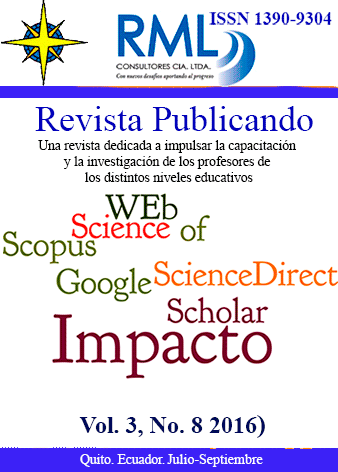Abstract
El estudio tuvo como objetivo analizar las tendencias reportadas en las investigaciones en elearning y puede considerarse como un estado del arte con aplicación de técnicas bibliométricas, Con el objetivo de poder revisar sólo publicaciones en revistas de reconocido prestigio científico, se decidió limitar la búsqueda a las revistas indexadas en Scopus y esta se .limitó a artículos en que apareciera en el título del mismo el término “elearning”. Los primeros artículos sobre elearning reportados aparecieron en el año 2002 y hasta el 2016 se pudieron obtener un total de 162 referencias, fundamentalmente en Ciencias Sociales, Computación, Medicina, Ingeniería; Administración y Enfermería. A partir de los artículos más citados se determinaron las 10 tendencias investigativas más importantes entre las que se encuentran: la caracterización de recursos efectivos para el elearning, el papel del elearning en la educación a distancia, la integración de recurso multimedia, la creación de nuevas experiencia de aprendizaje, la percepción de los estudiantes y la integración con las redes sociales. Desde el punto de vista de los métodos empleados en las investigaciones analizadas emplean mayoritariamente el análisis de casos y relativamente pocos estudios exploran los métodos cuantitativos para establecer modelos.
References
Abbad, M. M., Morris, D., Al-Ayyoub, A., & Abbad, J. M. (2009). Students' decisions to use an elearning system: A structural equation modelling analysis. International Journal of Emerging Technologies in Learning, 4(4), 4-13. doi:10.3991/ijet.v4i4.928
Alonso, J. A. G., Yánez, J. F. T., & Linzán, J. F. P. (2016). El marketing de guerrilla. Un estudio bibliométrico. Revista Publicando, 3(6), 471-484.
Cross, J. (2004). The future of eLearning. On the Horizon, 12(4), 151-157. doi:10.1108/10748120410564458
Dagger, D., Wade, V. P., & Conlan, O. (2004) Developing active learning experiences for adaptive personalised eLearning. Vol. 3137. Lecture Notes in Computer Science (including subseries Lecture Notes in Artificial Intelligence and Lecture Notes in Bioinformatics) (pp. 55-64).
Daneshgar, F., & Van Toorn, C. (2009). eLearning in the workplace versus eLearning in higher education. Australian Educational Computing, 24(1), 16-22.
Docherty, C., Hoy, D., Topp, H., & Trinder, K. (2005). eLearning techniques supporting problem based learning in clinical simulation. International Journal of Medical Informatics, 74(7-8), 527-533. doi:10.1016/j.ijmedinf.2005.03.009
Ellis, R. A., Jarkey, N., Mahony, M. J., Peat, M., & Sheely, S. (2007). Managing quality improvement of eLearning in a large, campus-based university. Quality Assurance in Education, 15(1), 9-23. doi:10.1108/09684880710723007
Forsyth, H., Pizzica, J., Laxton, R., & Mahony, M. J. (2010). Distance education in an era of elearning: Challenges and opportunities for a campus-focused institution. Higher Education Research and Development, 29(1), 15-28. doi:10.1080/07294360903421350
González, C. (2010). What do university teachers think eLearning is good for in their teaching? Studies in Higher Education, 35(1), 61-78. doi:10.1080/03075070902874632
Graf, F. (2002). Providing security for eLearning. Computers and Graphics (Pergamon), 26(2), 355-365. doi:10.1016/S0097-8493(02)00062-6
Hernández-Tovar, M. J., Fernández-Recio, E., Bosom-Nieto, í., Seoane-Pardo, A., & García-Peñalvo, F. J. (2007). Tutor online. An eLearning student view. WSEAS Transactions on Information Science and Applications, 4(2), 432-438.
Huttí¬r, O., Simonics, I., Szkaliczki, T., & Wagner, B. (2006). Standard-based elearning solutions in higher education. Periodica Polytechnica, Electrical Engineering, 50(3-4), 175-183.
Levesque, D. R., & Kelly, G. (2002). Meeting the challenge of continuing education with eLearning. Radiology management, 24(2), 40-43.
Lim, W. Y., So, H. J., & Tan, S. C. (2010). eLearning 2.0 and new literacies: Are social practices lagging behind? Interactive Learning Environments, 18(3), 203-218. doi:10.1080/10494820.2010.500507
Littlejohn, A., Falconer, I., & McGill, L. (2008). Characterising effective eLearning resources. Computers and Education, 50(3), 757-771. doi:10.1016/j.compedu.2006.08.004
Punnoose, A. C. (2012). Determinants of intention to use eLearning based on the technology acceptance model. Journal of Information Technology Education:Research, 11(1), 301-337.
Romanov, K., & Kuusi, T. (2009). Freeware eLearning Flash-ECG for learning electrocardiography. Medical Teacher, 31(6), 550-552. doi:10.1080/01421590802415595
Romanov, K., & Nevgi, A. (2007). Do medical students watch video clips in eLearning and do these facilitate learning? Medical Teacher, 29(5), 490-494. doi:10.1080/01421590701542119
Sanders, J., & Holsey, C. (2011). Perspectives on eLearning/distance learning. Imprint, 58(4), 40-41.
Sclater, N. (2010). ELearning in the cloud. International Journal of Virtual and Personal Learning Environments, 1(1), 10-19. doi:10.4018/jvple.2010091702
Weiss, A., Computing in the clouds (2007) Net- Worker, 11 (4), pp. 16-25. , New York: ACM; Wilson, S., Sharples, P., Griffiths, D., Distributing education services to personal and institutional systems using Widgets (2009) Proceedings of the First International Workshop on Mashup Personal Learning Environments, pp. 25-32. , Maastricht, Netherlands
Schneckenberg, D. (2010). Overcoming barriers for eLearning in universities-portfolio models for eCompetence development of faculty. British Journal of Educational Technology, 41(6), 979-991. doi:10.1111/j.1467-8535.2009.01046.x
Sorensen, E. K. (2008). Design of dialogic eLearning-to-learn: Meta-learning as pedagogical methodology. International Journal of Web Based Communities, 4(2), 244-252. doi:10.1504/IJWBC.2008.017675
Thompson, T. L., & MacDonald, C. J. (2005). Community building, emergent design and expecting the unexpected: Creating a quality eLearning experience. Internet and Higher Education, 8(3), 233-249. doi:10.1016/j.iheduc.2005.06.004
Yokota, M. (1988). Active and passive information transmission: technology of communication. [Hokenfu zasshi] The Japanese journal for public health nurse, 44(8), 714-718.
You are free to:
Share — copy and redistribute the material in any medium or format.
Adapt — remix, transform, and build upon the material.
The licensor cannot revoke these freedoms as long as you follow the license terms.
Under the following terms:
Attribution — You must give appropriate credit, provide a link to the license, and indicate if changes were made. You may do so in any reasonable manner, but not in any way that suggests the licensor endorses you or your use.
NonCommercial — You may not use the material for commercial purposes.
ShareAlike — If you remix, transform, or build upon the material, you must distribute your contributions under the same license as the original.
No additional restrictions — You may not apply legal terms or technological measures that legally restrict others from doing anything the license permits.
